The 49th state to join in the Union, Alaska (also known as the Frontier State) is an amazing state and an excellent place for seeing a large and diverse number of birds. You’ve got all kinds of areas, like glaciers, lakes, mountains, and even volcanoes! It’s an ecosystem truly as beautiful as it is diverse.
Today we will talk about the popular backyard birds that you can see here and give you a little information on what to look for, what they like to eat, and more! Let’s talk about the popular backyard birds of Alaska!
3 Categories – 500 Birds
Home either full or part-time to approximately 500 different Avian species, to say that Birders have more than a lot of their plate here when it comes to birdwatching in Alaska is putting it mildly. While we can’t explore all of the birds that Alaska has to offer in the space we have, we’ve taken a sampling of birds for you and divided them up like this:
- Year-round Resident birds
- Birds of Spring, Summer, and Early Fall
- Fall and Winter Birds
We’ll let you know what kind of foods they like, their identifying marks and colors of plumage, and even give you some tips on where to look for them when you are out and about. Let’s start with the birds here that you can see at any time of the year.
Alaska’s Year-round Resident birds
These Alaskan birds fell in love with the state, just like you did, and decided they were going to stay. That means that winter, summer, spring, or fall you can find them in various spots around the Frontier state. See if you can spot one or more of these birds this year:
- Downy Woodpecker
- Gray Jay
- American Dipper
- Golden-crowned Kinglet
- European Starling
Downy Woodpecker – Picoides pubescens
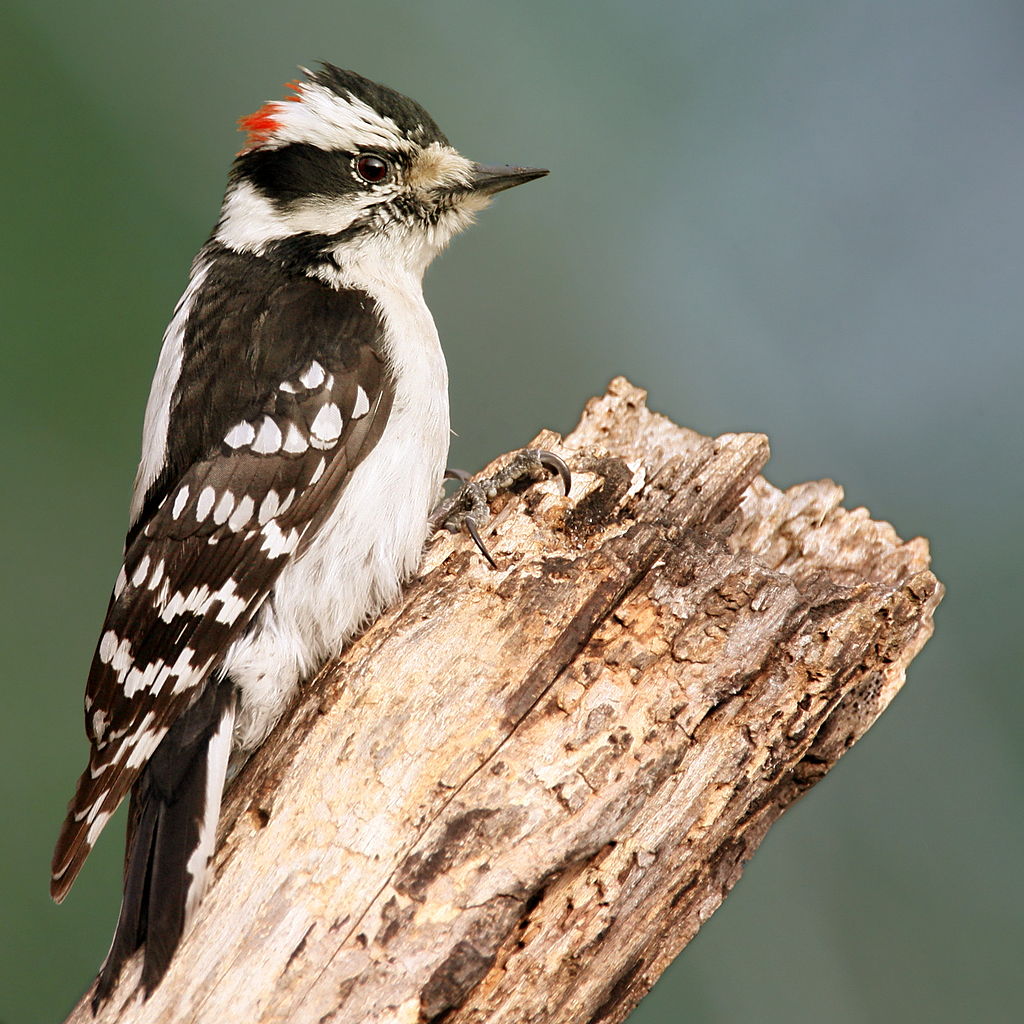
Coloration and Markings: Downy Woodpeckers have a broad, white stripe on their backs as well as large, black wings, which bear a checkerboard pattern made of white dots starting just below to the shoulder and going down to the wingtips. They also have short, notched tails which are black on top and white underneath. The underbelly and breast of this bird are a snowy white and facially, these birds have mostly-white faces with a black mustache line that terminates at a half-collar mark at the back of the throat. They also have a black ‘bandit’ mask and a black cap, which is completely black for female Downies but will terminate at a red-dot at the back of the head for males. These birds have medium-length, thin black bills.
Size: These birds measure in at 5.5 – 6.7 inches in length and have wingspans of 9.8 to 11.8 inches wide.
Habitat: These little Woodpeckers love deciduous trees, especially in areas with high grasses, weeds, and shrubs nearby.
Diet: While these birds eat a lot of insects, they aren’t very picky when it comes to snacks. Suet, crushed peanuts, and raisins are a great way to attract and keep their attentions.
Gray Jay – Perisoreus canadensis
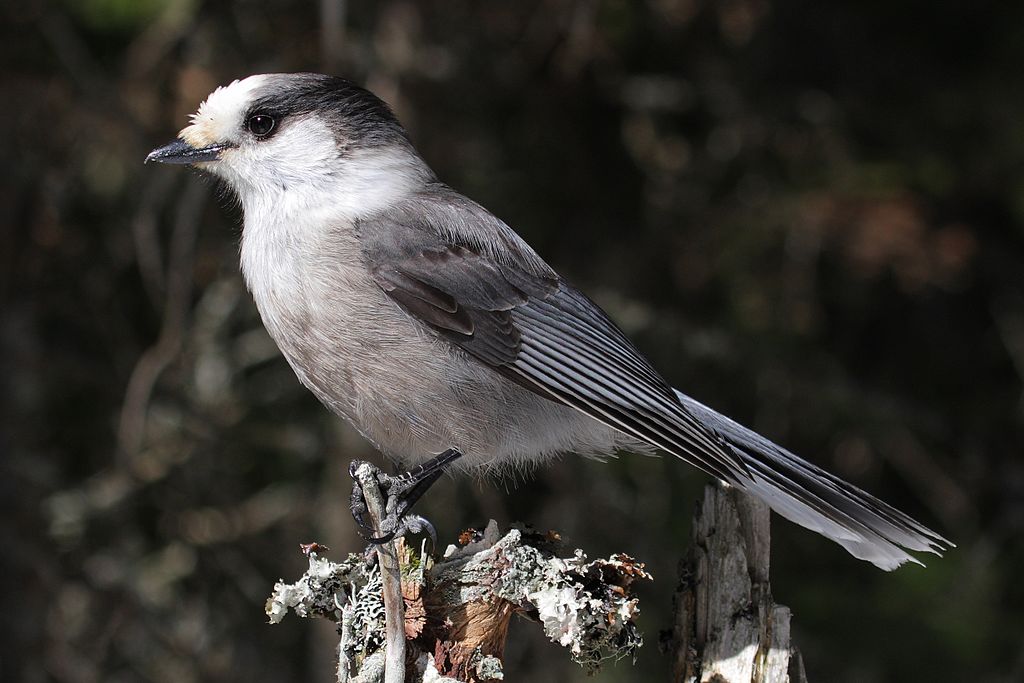
Coloration and Markings: Also known as ‘Canada Jays’ and even ‘Camp Robbers’ for their bold foraging habits, Gray Jays are lovely and easy to identify. They have dark gray backs with medium-length wings and long tails of the same color, though the underside of these tails will be a lighter gray outlined in white. The underbelly and breast of this bird are light-gray and this bird has a white bib of color coming down in a v-shape from the throat. Facially, these birds have mostly white faces, with dark gray to black on the back of the head, and a thin, fark gray mask connecting to this color. With its small, triangular black bill these birds seem to have large foreheads, making them look like quite the feathered intellectuals. Juveniles will be grayish-black overall with some lighter coloration just at the base of the bird’s bill.
Size: These birds measure in t 9.8 – 11.4 inches from tip to tail and have wingspans approximately 18 inches wide.
Habitat: Gray Jays prefer woodlands which are an evergreen and deciduous mix.
Diet: Suet, cracked corn, and mealworms are favorite foods of Gray Jays. Small fruits and berries are also good as well, especially blackberries, grapes, and cherries.
American Dipper – Cinclus mexicanus
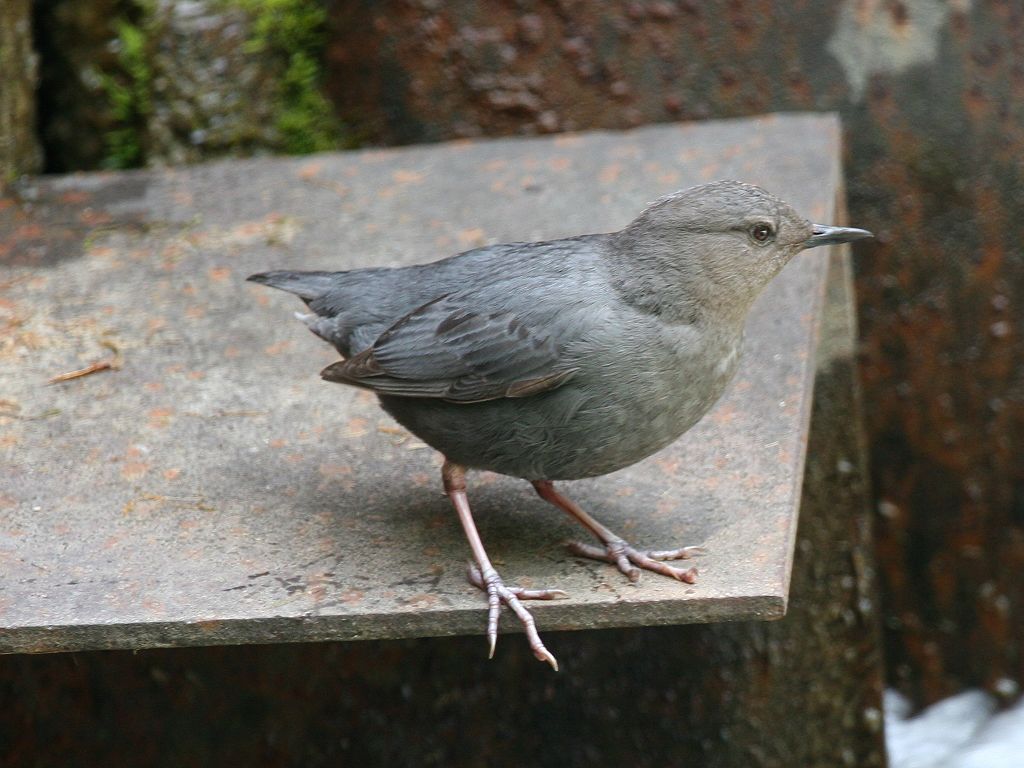
Coloration and Markings: American Dippers are stocky, often plump birds which are grayish brown overall in color, with some paler color at the throat and coming down in a v-shape at the breast, typically in a creamy tan or white. They have small wings and small, almost nubby tails. These birds have long, straight bills which will be completely dark during the breeding seasons. Juvenile Dippers will have yellowish bills and display barring patterns at the underbelly and breast.
Size: These birds measure in at approximately 7 inches in length and have wingspans averaging 9 inches wide.
Habitat: These birds swim for their summer, so you won’t be able to lure them to your feeder but if you have a stream on your property then you might well spot one foraging in its waters.
Diet: These birds eat mostly aquatic insects, though they do also like snails, worms, and fish eggs as well.
Golden-crowned Kinglet – Regulus satrapa
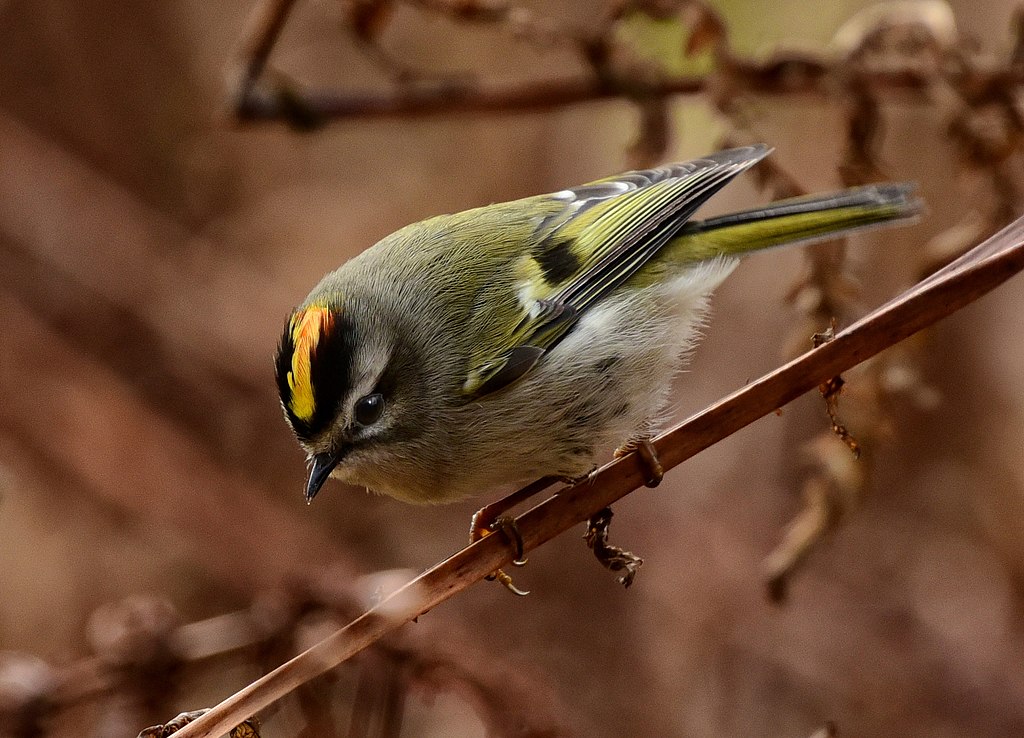
Coloration and Markings: Golden-crowned Kinglets have gray and yellowish-green backs with small wings and thin, perky yellow and gray tails. The underbelly and breast of this bird are white with a faint streaking of light-gray and facially, these birds have come white around the eyes and the chin, with a thin, black mustache line and a thin, gray mask. The back of the head is light gray with their signature black-topped-with-golden-yellow crowns. These birds have small, straight black bills. These little birds are hard to spot the first time but once you get a good look it’s definitely quite the treat.
Size: These little birds measure in at a mere 3.1 – 4.3 inches from tip to tail and have wingspans of 5.5 to 7.1 inches wide.
Habitat: During the warmer months these Kinglets spend most of their time in coniferous woodlands, though when it gets colder then you can spot them just about anywhere.
Diet: These birds mostly eat spiders and small insects that they can catch, though occasionally you can tempt one for a visit with some small seeds like Nyjer thistle and they will occasionally sample chopped or whole small berries.
European Starling – Sturnus vulgaris
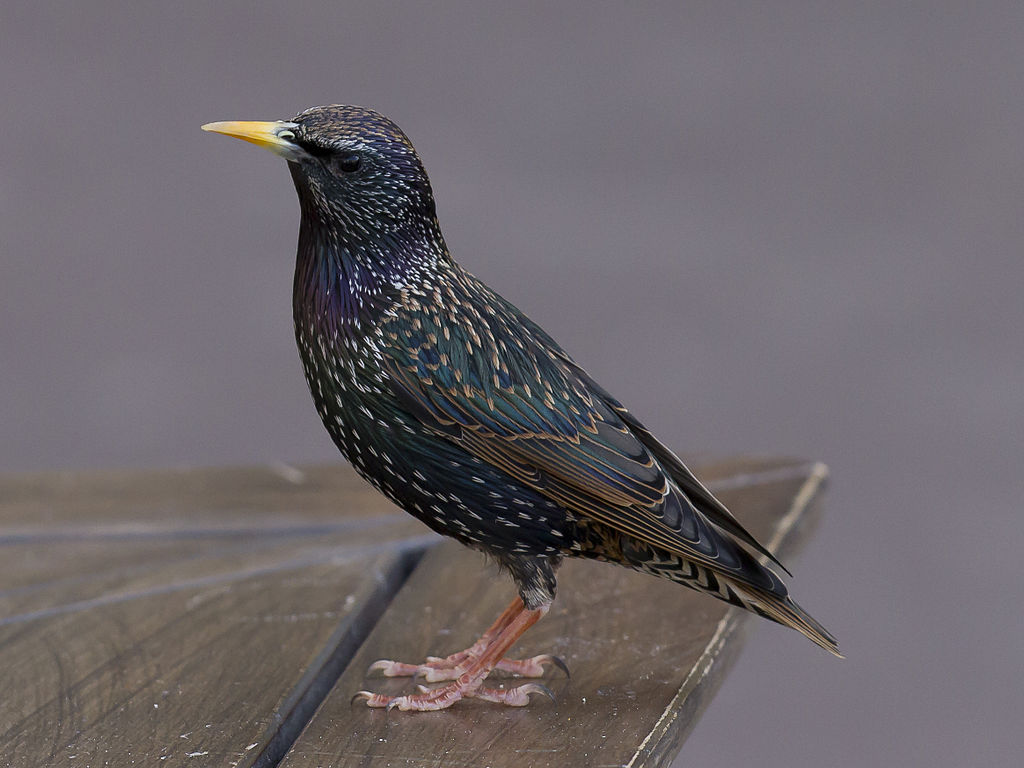
Coloration and Markings: European Starlings have a lovely purplish-green plumage that covers their whole bodies, and looks quite spectacular up close but simply black from a distance. They have long, pointy wings and broad, short tails and this looks like a 4-pointed star when the bird is in flight. These birds have long, straight yellow bills and in the winter they change their plumage quite dramatically. At this time, they will be brown with a lovely scattering of white spots.
Size: These birds measure in at 7.9 – 9.1 inches in length and have wingspans of 12.2 to 15.8 inches wide.
Habitat: While they do visit farms on occasion (where they are considered a bit of a pest), you are much more likely to spot Starlings just about anywhere in the city.
Diet: Starlings absolutely love suet but you can also make them quite happy with wheat, rolled oats, and just about any sweet fruits that you happen to have handy.
Alaska’s Birds of Spring, Summer, and Early Fall
With temperatures ranging between 41 and 59 degrees, the springtime is a little brisk but that’s just how Alaskan birds like it. See if you can spot one of these birds when they arrive during spring until the early fall:
- Lincoln’s Sparrow
- American Pipit
- Yellow-rumped Warbler
- Gray-cheeked Thrush
- Rufous Hummingbird
Lincoln’s Sparrow – Melospiza lincolnii

Coloration and Markings: Lincoln’s Sparrows have gray backs with dark brown and buffy streaking present flanking the breast and underbelly as well. They have a white underbelly, though the streaking is quite heavy around it and at the breast and facially, these birds are mostly gray, with a white mustache line topped with a thin line of brown, a brown eyeline, and a striking brown and gray cap on top. These birds have small, stout, and conical gray bills.
Size: These birds measure in at 5.1 – 5.9 inches in length and have wingspans of 7.5 to 8.7 inches wide.
Habitat: These birds prefer willows, cottonwoods, and aspen trees, and can sometimes be spotted in meadows or fields if you are watching the brush closely. Most likely if you spot one it will be during the spring, when the males can occasionally be spotted in a tree or some shrub cover as they sing to attract a mate.
Diet: Mealworms and White Proso millet are your best lures for getting a Lincoln’s Sparrow to leave their brush cover for a quick snack at your backyard feeder.
American Pipit – Anthus rubescens
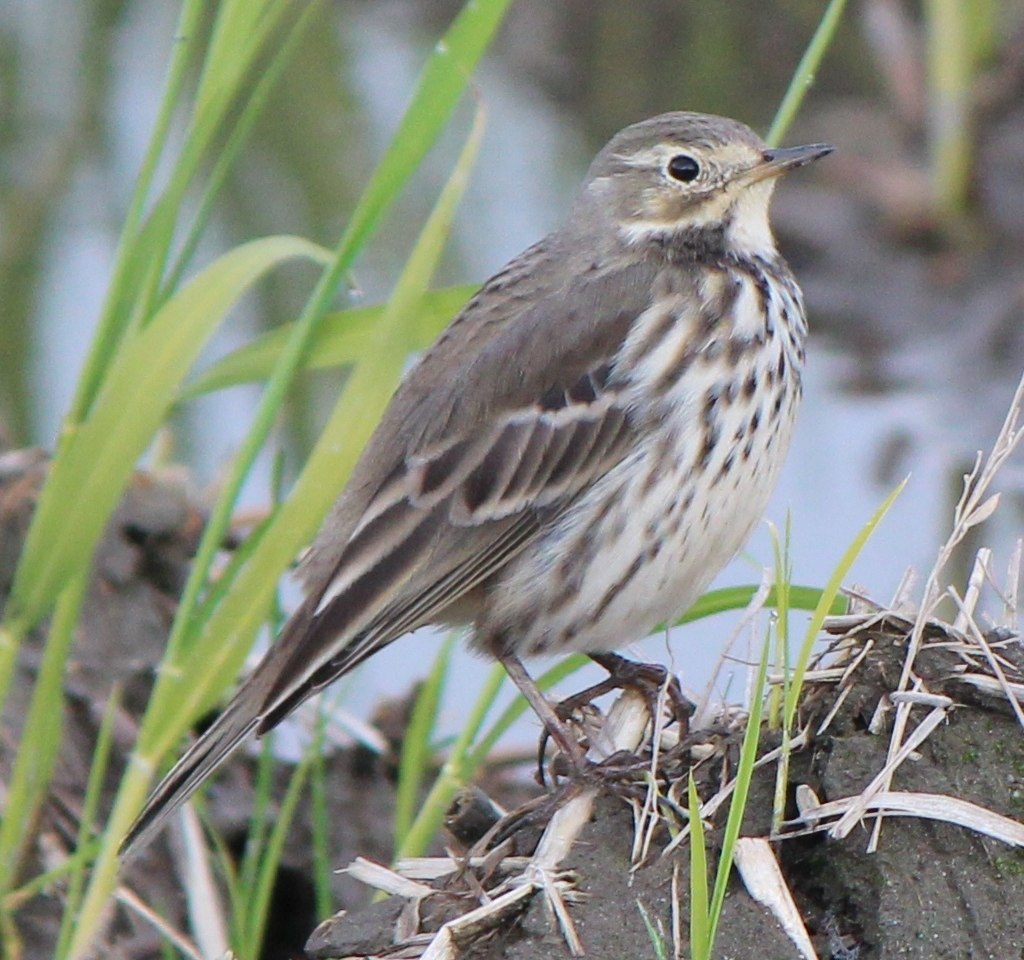
Coloration and Markings: American Pipits have brown or gray and brown plumage on their back and most of their upper bodies. They have medium-length wings and tails, which will be gray or gray and brown with some minute white edging in the wingfeathers and at the tail. The underbelly and breast of this bird are typically a ‘dirty white’ mix of whites and grays, though you can occasionally see a creamy tan coloration in these birds as well at the beast and throat. Facially, these birds have gray heads with a small amount of white around the eyes and a very thin gray or buffy eyeline is sometimes visible. These birds have long, thin, black bills and their plumage often takes a little streaking on in the winter at the breast and under the wings.
Size: These birds measure in at 5.5 – 6.7 inches in length and have wingspans of approximately 10.6 inches wide.
Habitat: These birds love open areas such as airfields, meadows, and even sandbars.
Diet: While they eat mostly insects, they do supplement their diets with small seeds, so you might have a little luck with a ground feeder and some Nyjer thistle.
Yellow-rumped Warbler – Setophaga coronata

Coloration and Markings: Yellow-rumped Warblers have gray backs with a little black spotting to accent them. They have medium-length gray wings which will have varying amounts of white and they have long, thin tails which are dark gray or even black at the corners of the tips. While it is hard to spot sometimes, the signature ‘yellow rump’ is just a bright yellow spot you can see close to the wingtips if you get a good look. Most of the rump is actually white, as well as the underbelly, but as the white moves up to the breast there is a heavy flanking of black streaks at the sides which gets denser as it approached the face. Some bright yellow will also be apparent under the wings and on the chin and throat of this bird, with the remainder of the face being gray except for a white eyering and a very small bit of yellow at the top of the head. These birds have straight, medium-length bills. Females will have more muted colors and sometimes tend to brown and both genders will get a bit of brown in the winter, though their yellow markings will be easiest to see at this time.
Size: These birds measure in at 4.7 – 5.5 inches in length and have wingspans of 7.5 to 9.1 inches wide.
Habitat: These Warblers are especially fond of open, coniferous woods and deciduous varieties as well. In the winter they range out a bit more, and just about any open, wooded areas are okay, especially if there is a lot of brush cover.
Diet: While primarily insectivorous, in the winter these birds will take small seeds and berries (they can actually digest the wax from a number of small berries!). Try leaving out a little Nyjer thistle and some raisins or blueberries and you might have some luck. Another trick with these birds is to smear a little suet on some tree bark in your backyard and see if this attracts them. You might be pleasantly surprised!
Gray-cheeked Thrush – Catharus minimus
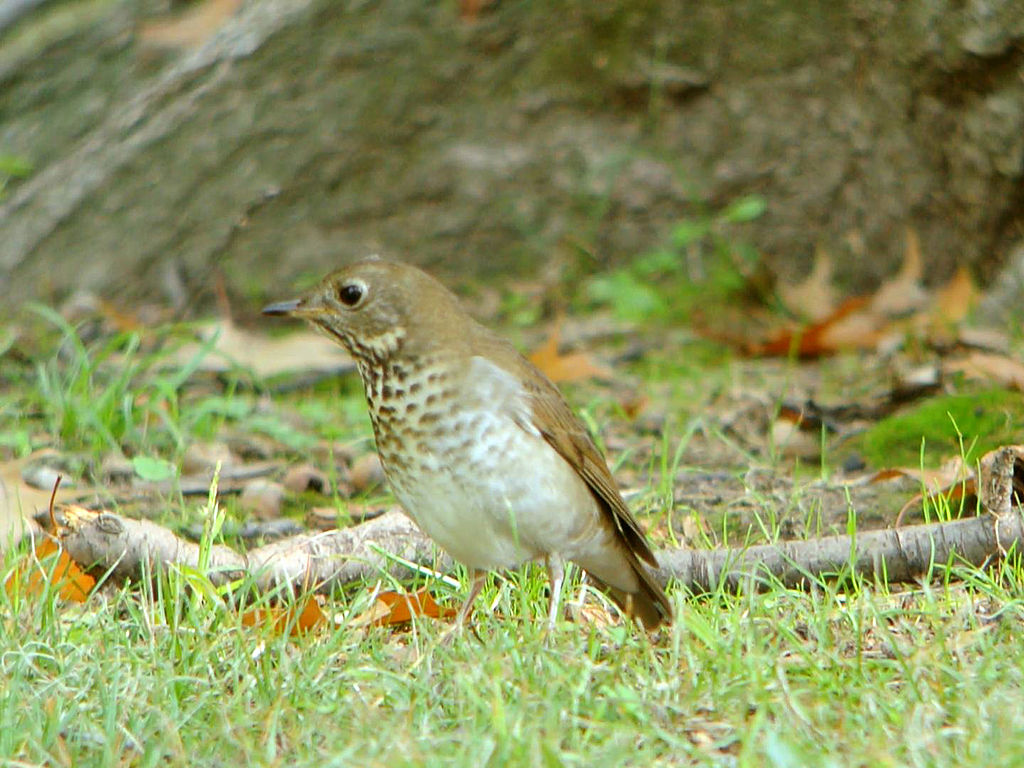
Coloration and Markings: The Gray-cheeked Thrush has a grayish-brown back with long wings and a relatively short tail. The underbelly of this bird is a lighter gray, with spotting or stippling patterns at the flanks which thicken at the breast. Facially, you might see some traces of white, but this bird’s face is mostly gray and sometimes displays a thin trace of partial eyering. These birds have long, stout, straight black and yellow bills.
Size: These birds measure in at 6.3 – 6.7 inches long and have wingspans of 12.6 to 13.4 inches wide.
Habitat: These birds like to spend their time in berry bushes and they are also fond of cottonwoods, alders, and willows. Look for them where the vegetation is dense and you might just spot a Gray-cheeked Thrush.
Diet: These Thrushes have a pretty diverse diet, eating worms, crayfish, and any spider that they can catch. They also like small, sweet fruits and berries, so you can sometimes tempt them in with cherries, raisins, grapes, or raspberries.
Rufous Hummingbird – Selasphorus rufus
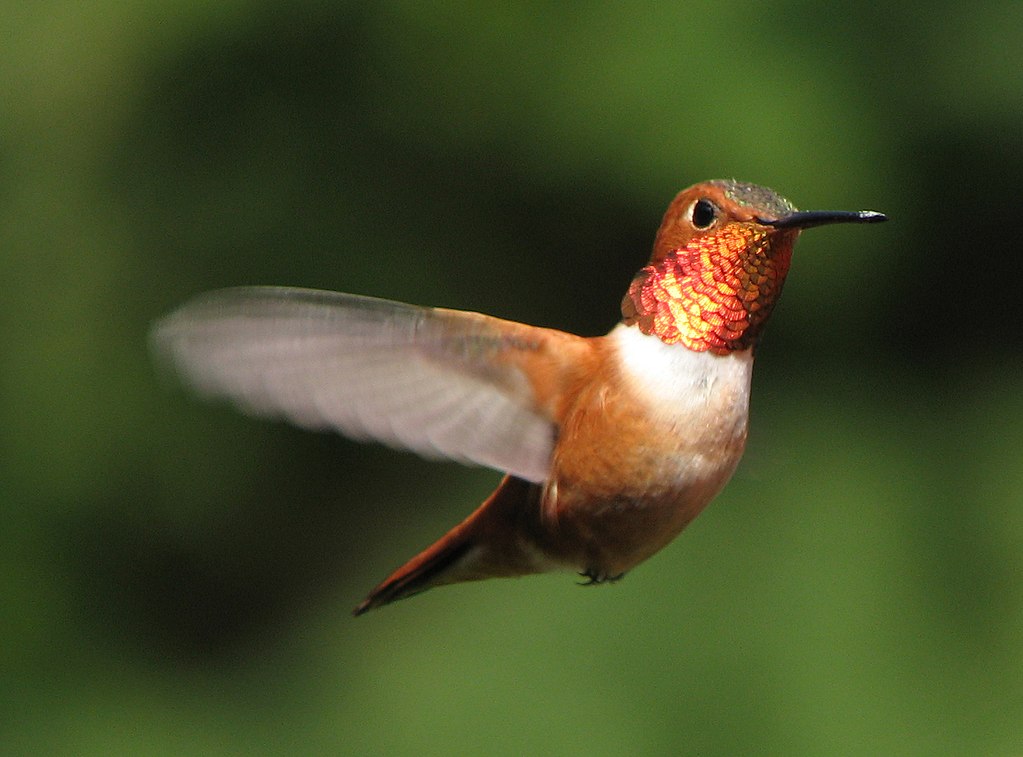
Coloration and Markings: Rufous Hummingbirds are quite beautiful. Males have bright orange backs with small wings and tails, with the wings being a mix of dark gray and red and the tails a mix of dark gray and orange. The underbelly and breast of this bird are white, with a dapper orange ‘vest’ of color flanking the white on both sides, and this bird’s head is mostly orange, with some shiny red at the throat and a bit of orange/gray at the forehead. Females have a lovely contrast of colors, with green on their upper body with a bit of orange at the throat and the same rufous ‘vest’ seen on the males. Some rufous is sprinkled into the tail color as well.
Size: These tiny Hummingbirds measure in at 2.8 – 3.5 inches from head to tail and have wingspans of approximately 4.3 inches wide.
Habitat: While sometimes found in the mountains during migration periods, these birds spend most of their time in open, wooded areas such as meadows, copses, and the forest’s edge.
Diet: Sugar water in your hummingbird feeder will do and you might put out some mealworms as a treat. These birds mostly eat flying insects but will likely gobble up those mealworms once they are spotted.
Alaska’s Fall and Winter Birds
Winters in Alaska are the stuff of stories, with temperatures as low as 0 – -30 degrees. You’ll want a coat, yet somehow these birds are managing just fine. Leave a little something out and a heated-birdbath if you’ve got one for these stunning winter birds of Alaska:
- Rock Pigeon
- Bohemian Waxwing
- Pine Grosbeak
- Hoary Redpoll
- American Robin
Rock Pigeon – Columba livia
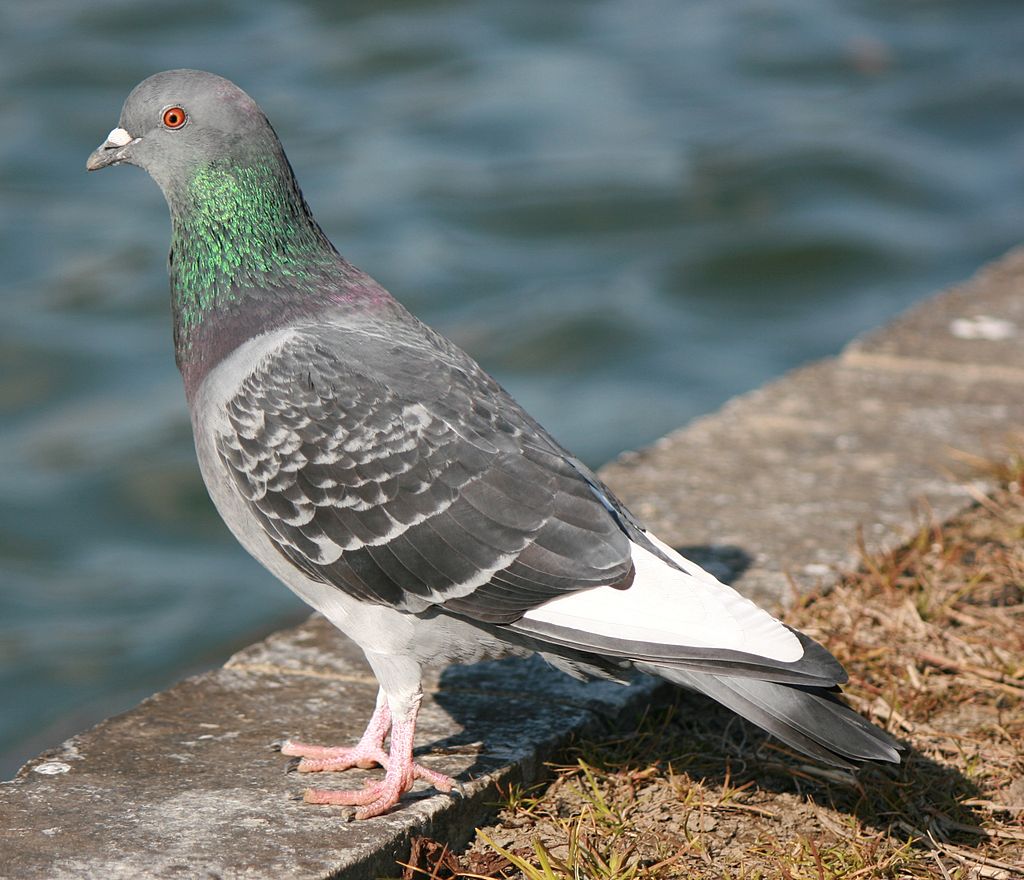
Coloration and Markings: Also known as the Rock Dove, the Rock Pigeon is the bird which domestic pigeons are descended from. These large birds have quite a bit of variance in their plumage but in general, they are bluish-gray on their back, their long, pointy wings, and short, rounded tails. Typically the tail is black tipped and you can sometimes see two black bands very distinctly on the wings, though a few Rock Pigeons may not have them. The underbelly and breast of this bird are typically a dark or lighter gray up until you get to the bird’s long neck, which is an iridescent mix of purple and green. Facially, these birds are gray with a straight, medium-length black bill that often has a white band on top at the start of the bill.
Size: These birds measure in at 11.8 – 14.2 inches in length and have wingspans of 19.7 to 26.4 inches in width.
Habitat: While you may indeed find them in crags and cliffs, these birds know where to get the good snacks and are quite happy to visit farms and cities to forage close to us.
Diet: Nyjer thistle and White Proso millet are good choices for Rock Pigeons and they do also fancy a berry or two if you’ve got some.
Bohemian Waxwing – Bombycilla garrulus
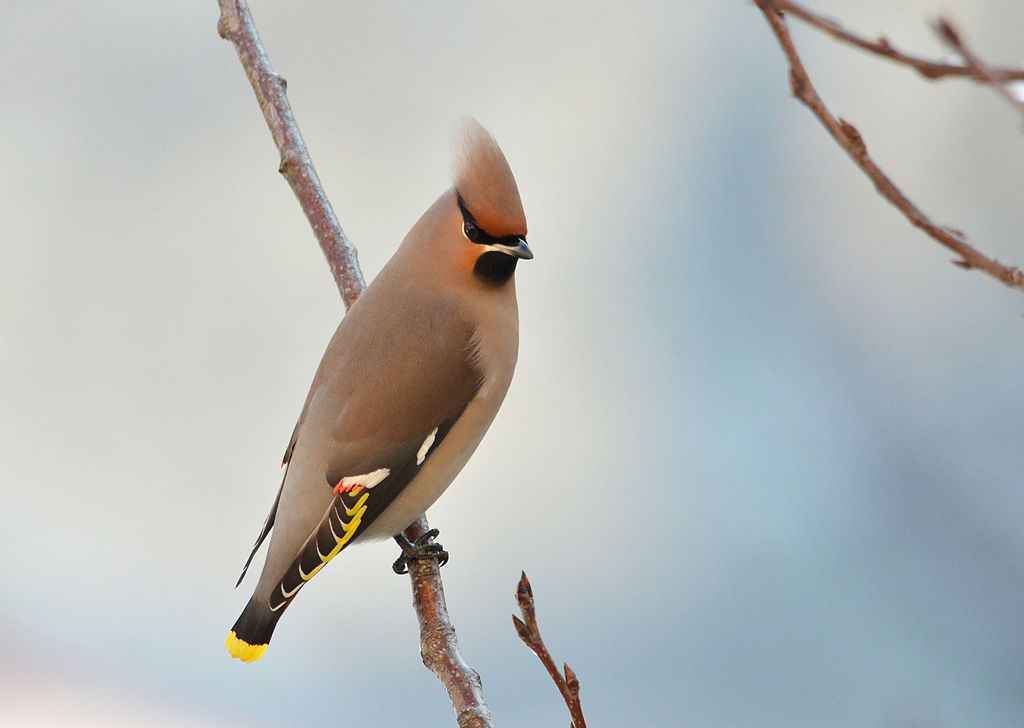
Coloration and Markings: Bohemian Waxwings are a sight to see, with their soft, gray backs, their broad, medium-length gray wings and their short, somewhat squared gray tails. The wings will have 2 rectangular patches, with a waxy-red marking also visible that looks much like a ‘Pan’s pipe’, like an ascending arrangement of reeds. The tail is will be bright yellow at the tip, with a line of black above it on the top and on the underside, a lovely peach or rusty hue will be seen. The underbelly and breast of this bird will be a slightly lighter gray and facially, these birds will be mostly a reddish-peach color, with the exception of a black chin and a very distinct black mask that curls up into this birds lovely crest. These birds have short, stout, and slightly curved black bills with a tiny amount of white color outlining them at the face and continuing as a thin line under the mask. Juvenile Waxwings will lack the waxy-red and reddish-peach face coloration, tending to be more overall gray, with some visible streaking at the breast and underbelly.
Size: These birds measure in at 6.3 – 7.5 inches in length and have wingspans of approximately 13 inches wide.
Habitat: In the warmer months, these birds spend most of their time in evergreen forests, though as it gets colder they prefer to be near water or in areas such as parks or backyards, especially where orchards and gardens have been cultivated.
Diet: While they mostly eat insects in the warmer months, these birds do like fruits and berries and eat quite a lot of them in winter. Chopped apples, an orange half, and cherries or blueberries should be met with much enthusiasm from the Bohemian Waxwing.
Pine Grosbeak – Pinicola enucleator

Coloration and Markings: Male Pine Grosbeaks have red or reddish prink and gray backs, with medium-length gray wings sporting 2 white wingbars and they have long, notched, and gray tails with some red seen up top at the rump. The underbelly will be gray while the breast will be pinkish-red and facially, male Pine Grosbeaks are mostly reddish-pink with a swathe of gray around the eyes and a very stout, slightly curved gray bill. Females and juveniles tend to be reddish orange or even yellow at the head and the rump and while there is typically a lot of color, it may vary quite a bit between different Pine Grosbeaks.
Size: These birds measure in at 7.9 – 9.8 inches in length and have wingspans of 13 inches in average width.
Habitat: These birds love open stands of spruce and pine, though in the winter you can also find them quite commonly around ash and maple trees.
Diet: In the wild, these birds eat spiders, seeds, buds, and fruits, so the best way to get their attention is some small Black Oil Sunflower seeds, Nyjer thistle, and perhaps some grapes, chopped-up cherries, or whatever other berries you might have to spare.
Hoary Redpoll – Acanthis hornemanni
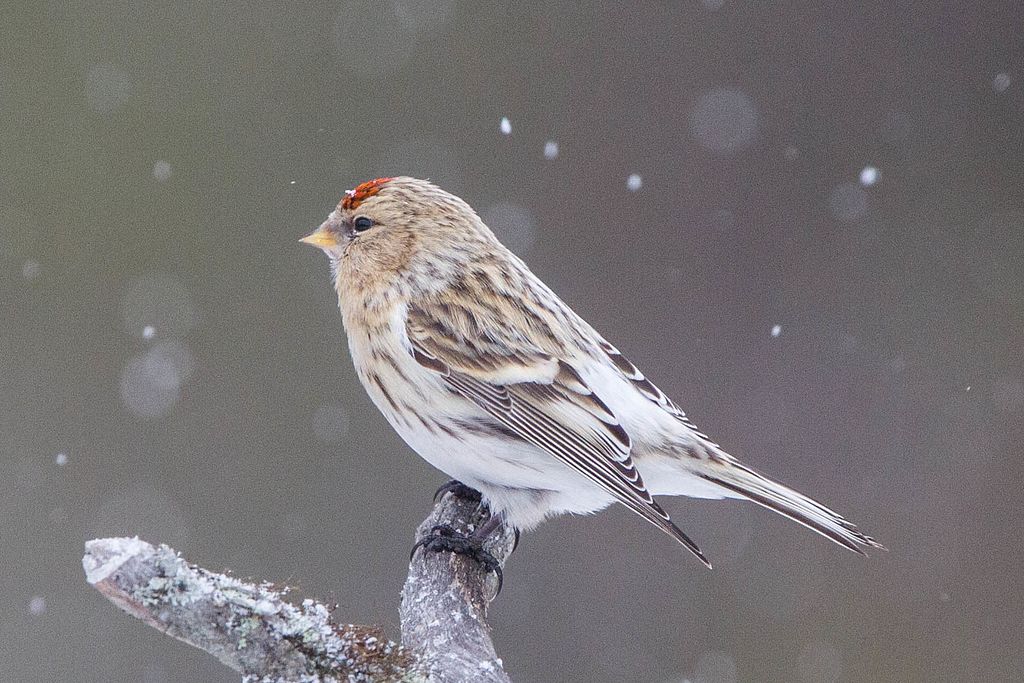
Coloration and Markings: Tundra-loving birds, Hoary Redpolls look like they are wearing very fluffy coats. They have very white backs with brownish-gray streaking as well as small, gray wings with a bold white wingbar visible on each. Their tails are short, notches, and gray on top while being white on the undersides. The underbelly and breast of this bird are white with the brownish-gray streaking and facially, they are mostly the streaked-white color, with the exception of some buff coloration around the eyes, at the cheeks, and minutely-but-visibly at the chin. A bold and distinctive red mark will be at this bird’s forehead and the overall fluffiness of the Redpoll’s face makes it’s small, triangular yellow bill look very small indeed. Juveniles tend to be brown with a bit more streaking and females are not quite as bright in color as the males. On occasion you can also see a lovely pink or rose hue at the breast and the rump but it will not be there on every Hoary Redpoll that you spot.
Size: These birds measure in at 4.7 – 5.5 inches in length and have wingspans that average at 9 inches wide.
Habitat: Found in weedy fields, areas with lots of shrub cover, and the cracks and crevices of rocks where they commonly nest, Hoary Redpolls are also quite avid visitors of backyard feeders where they have been made to feel welcome.
Diet: Nyjer thistle and hulled or broken-up Black Oil Sunflower seeds are favorites of this bird.
American Robin – Turdus migratorius
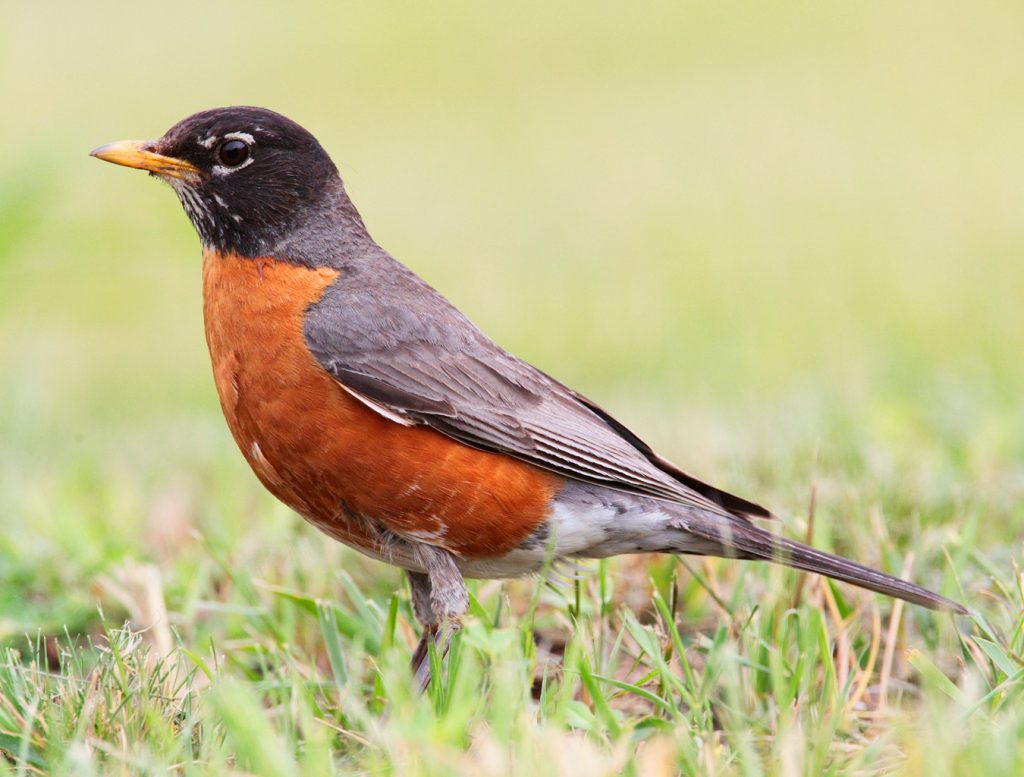
Coloration and Markings: American Robins have grayish-brown backs, with medium-length grayish-brow wings and long, gray tails which will be white on the undersides. They have a white rump, but their underbelly and breast are a lovely reddish-tangerine hue that really gets your attention. Facially, these birds have dark gray to black heads, with a fragmented white eyering being visible on each eye and a medium-length, lightly curved yellow bill that often has a little black at the tip. Females will have the same coloration but the colors are less bright, showing a much tamer contrast than what is displayed by the males.
Size: The largest of North American Thrushes, these birds measure in at 7.9 – 11 inches in length and have wingspans of 12.2 to 15.8 inches wide.
Habitat: These birds have a wide-range of habitats, being equally comfortable in tundra, golf courses, parks, or your backyard garden. They are also quite fond of pine and deciduous woodland or anywhere that there is a bit of shrub cover to make them feel safe.
Diet: Suet, crushed peanuts, and raisins are 3 keys to any Robin’s heart. Be sure to leave a little out for them as you’ll always catch your breath a little and smile when you spot one of these striking birds.
Supporting cast (Other Backyard Birds of Alaska that might pay you a visit)
While they aren’t front-page hogs like our year-round resident birds, our humble ‘Supporting Cast’ birds are still quite stunning and available all year ‘round for those who keep an eye out (and hopefully a delicious snack) for. See if you can spot one of these Supporting Cast birds this year:
- Hairy Woodpecker
- Stellars Jay
- Raven
- Ruby-crowned Kinglet
- Dark-eyed Junco
Hairy Woodpecker – Dryobates villosus
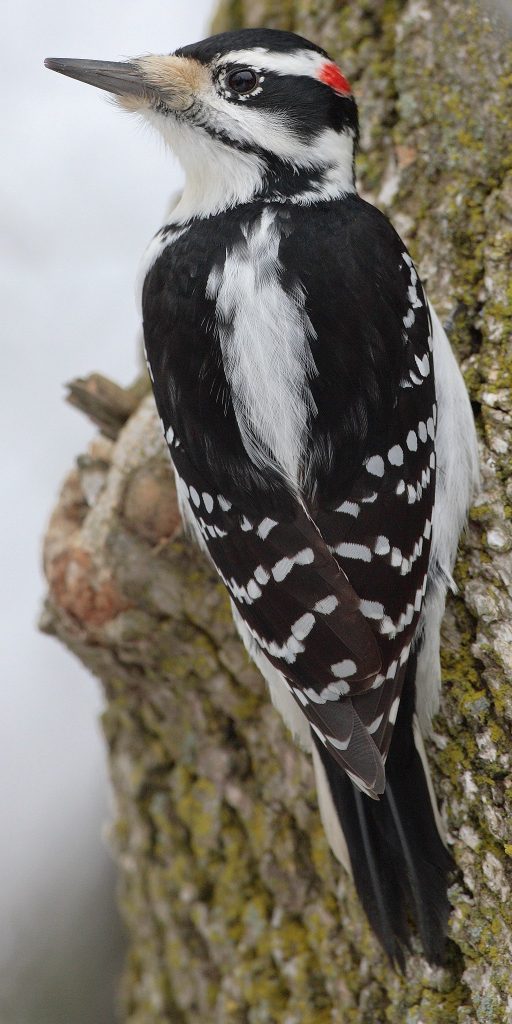
Coloration and Markings: Hairy Woodpeckers look exactly like Downy Woodpeckers, only about 1/3 larger in size and with slightly larger tails. They have a broad, white stripe on their backs and the black half-collar on the back of the neck, as well as long wings which are black with white checkerboard-style markings starting just below the shoulder and going down to the tips of the wings. Note that there is some regional variance, so some may be less spotted than others. They have short, stout, and notched tails which are black on top and white underneath and the underbelly and breast of this bird are a snowy white though tan color is not unheard of. Facially, they have mostly white faces with a black mustache line that carries down to the back of the head and circles around, as well as a bandit mask and a black cap that will show a bit of red at the back of the head if you are looking at a male. These birds have long, stout, and sometimes even slightly upturned black bills.
Size: These birds measure in at 7.1 to 10.2 inches in length and have wingspans of 13 to 16.1 inches wide.
Habitat: The birds love older woods, especially with lots of pine or oak stands around. They may found here or at the edge of said forest, though they are also quite bold and range into parks and backyards with little or no fear at all.
Diet: Peanut butter mixed with suet, crushed peanuts, raisins, and some Black Oil Sunflower seeds will make for one or more very happy Woodpeckers at your feeder!
Stellars Jay – Cyanocitta stelleri
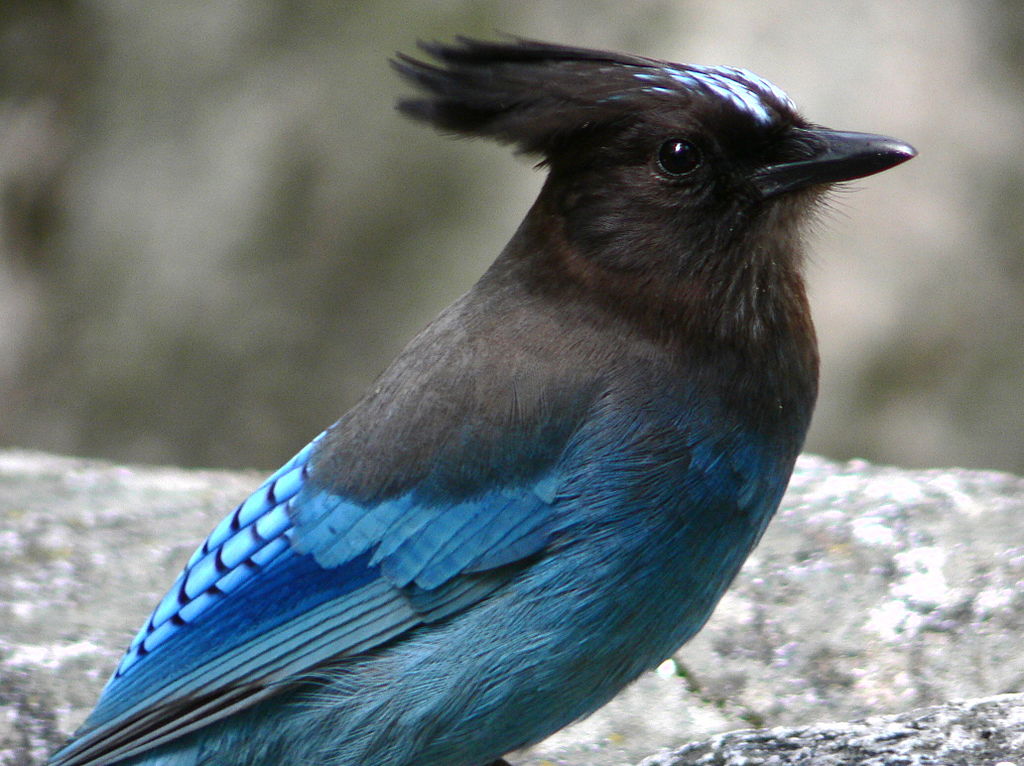
Coloration and Markings: Stellar’s Jays are quite striking, with their black backs and medium-length wings which are black at the shoulders, but a vivid dark blue with a crisscross of black lines accentuating the color in the center of the wings when at rest. The wingtips will generally be black as well and these birds have very long, full tails which are also blue with the black lines across them. The underbelly and breast of this bird are grayish-blue, with the hue darkening towards the top of the breast as it approaches the bird’s black head. Facially, black is the primary color, however at the forehead you will note that the bird’s large and quite majestic black crest will have 2 blue or white markings present. These birds have long, stout black bills with a slight downward curve to the upper bill. Thin, white eyebrow lines are also present if you are able to get a good look.
Size: These birds measure in at 11.8 – 13.4 inches in length and have wingspans of approximately 17.3 inches wide.
Habitat: Found in evergreen forests at elevations anywhere between 3000 and 10,000 feet, Stellar’s Jays are also quite fond picnic rest-stops, parks, and backyards as well.
Diet: These birds love peanut butter, Nyjer thistles, and Black Oil Sunflower seeds but you should be warned, they will also eat baby birds and Hummingbirds on occasion. Due to this, while they are quite striking, you may or may not want to encourage them to stay in your backyard. If one has arrived and you are worried, a plastic Owl or realistic looking rubber snake can sometimes drive them away.
Raven – Corvus corax
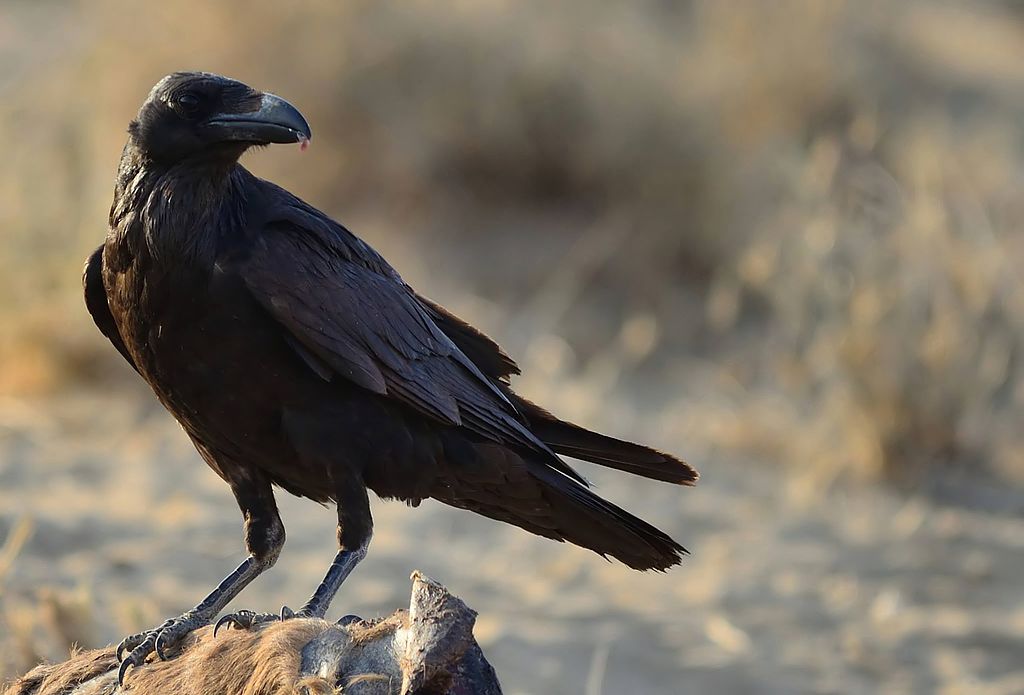
Coloration and Markings: If you’ve never seen a real Raven, they are all over Alaska and you can’t miss them. While they are common, they are clever birds and sometimes quite a treat to have in your backyard. Ravens are completely black, even their eyes and their legs. They have large, broad wings and medium-length, broad tails and facially, you can’t miss their bills which are long, stout, and technically straight, though there is a distinctive downward curve of the upper bill
Size: Good-sized birds, Ravens measure in at 22.1 – 27.2 inches from head to tail and have wingspans of 45.7 to 46.5 inches wide!
Habitat: Ravens go pretty much where they want to, though they have a fondness for evergreen and deciduous woodlands. That said, you can see them quote often just about anywhere, be it by the coast, at farms, or just looking around the city.
Diet: Ravens will eat just about anything and these smart birds even work together when they are in flocks if they want to get something. You can leave things like boiled eggs, peanuts, and even your table scraps out for them but be careful with the last, as you don’t really want to be feeding them anything salty.
Ruby-crowned Kinglet – Regulus calendula
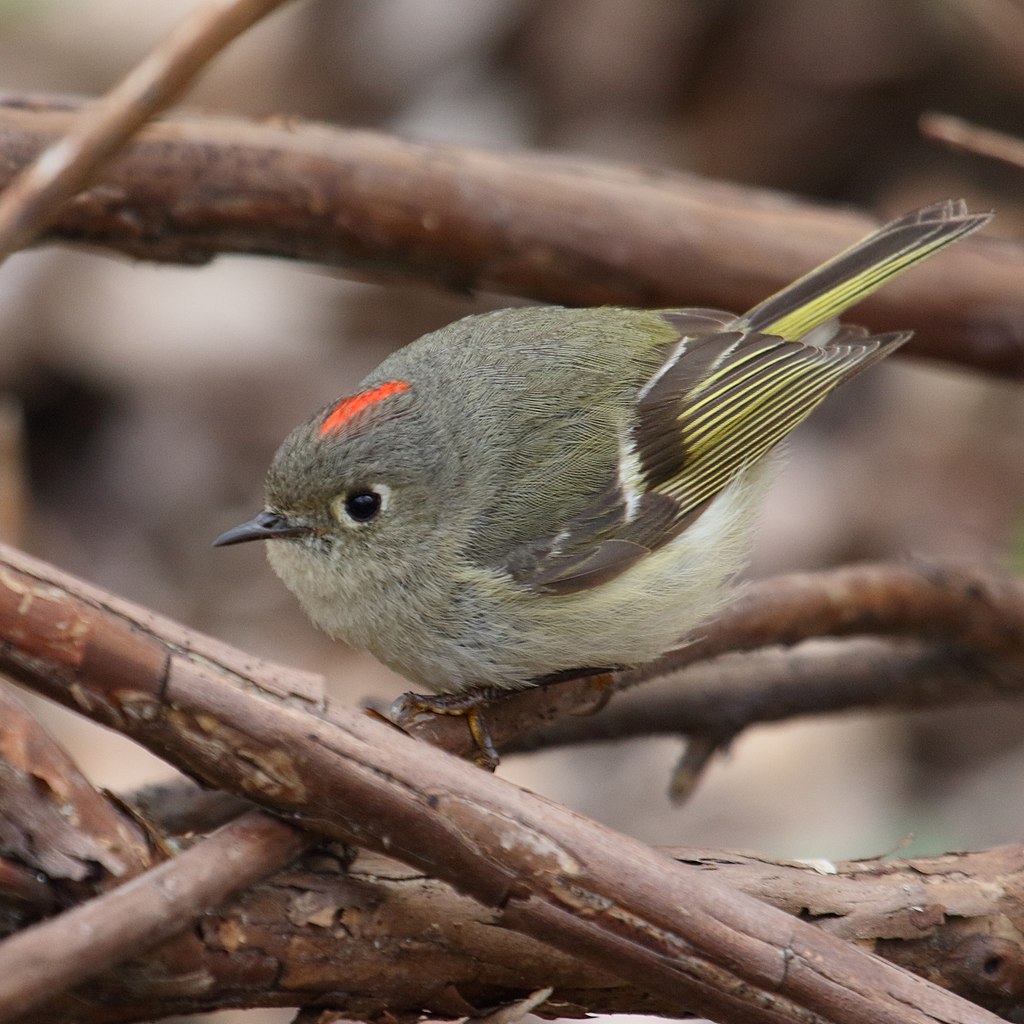
Coloration and Markings: Ruby-crowned Kinglets have soft, gray backs with gray wings that are mixed with olive-green coloration. They have small wings with distinctive white wingbars, bordered by thick, black lines and they have short, perky gray and olive tails. They have white rumps but their underbellies will have a mix of yellowish color to them, darkening to more of a gray mixed with white as the color proceeds up the breast. Facially, these birds are mostly gray, with the exceptions being a white eyering and the lovely red crowns that give them their name. Note, only the males will have the red crowns. These birds have thin, medium-length, and straight black bills.
Size: These little beauties measure in at 3.5 – 4.3 inches in length and have wingspans of 6.3 to 7.1 inches wide.
Habitat: In the warmer months, these birds prefer coniferous woods but in the winter you can find them ranging out into deciduous woodlands and just about anywhere that there is a lot of shrub cover. They are happy to visit backyards with well=stocked feeders, as well, so keep an eye out for them.
Diet: While they eat a lot of insects, Ruby Kinglets have also been known to visit suet feeders and they like broken-up or hulled Sunflower seeds as well.
Dark-eyed Junco – Junco hyemalis

Coloration and Markings: While there is a lot of regional variation, typically Dark-eyed Juncos will be dark brown or gray on their upper bodies. They have grayish or brown backs, with medium-length wings, and long tails of the same color… although there will be white outer feathers on the tail and the undersides will be white as well. The underbelly and breast of this bird are white, with a flanking of gray or brown that increases in density as the color moves up the breast with the effect being much like the bird is completely white on only the lower 3rd of the bosy (when the bird is viewed at rest(. Facially, these birds are gray or brown with stout, medium-length, and conical pink bills.
Size: These birds measure in at 5.5 to 6.3 inches in length and have wingspans of 7.1 to 9.8 inches wide.
Habitat: During warmer months Juncos prefer coniferous or mixed-coniferous forests, ranging out more often to other types of open wooded areas during the winter. This is the time that you will most likely spot them in parks and backyards, as well, so be sure to leave a little something out for them.
Diet: White Proso millet, cracked corn, and broken-up Black Oil Sunflower seeds are all favorites of the Dark-eyed Junco.
Alaska Bird Buffet
Alaskan birds are tough but they need a little help on your end to stay warm and happy. That’s why today we are sharing a little of our own advice as well as some tips from the Alaska Department of Fish and Game for some good foods to feed the birds in Winter that are still great choices at any time of the year. Try adding one of more of the items below to your feeder and if you’d like to read the original article, just check our references and the link will be waiting for you! Here are some recommended foods for keeping your feathered friends happy and warm:
- Black Oil Sunflower seeds
- Peanut butter mixed with rolled oats or even animal fat
- Low water content fats may be obtained at the grocer and are less likely to freeze
- Cranberries
- Blueberries
- Crushed peanuts
Alaska Birding Hot Spots
When you want to see a little bit of Alaska and the feathered celebrities that live here, be sure to check out one or more of these Chirparazzi-recommended hotspots. We have a number of scattered locations you can check out but be sure to bring your camera as you really can see some amazing birds in this state. Here are the recommended hotspots:
- Popular hotspot #1 – Friends of Creamer’s Field Wildlife Sanctuary
- Popular hotspot #2 – Chilkat Bald Eagle Preserve
- Popular hotspot #3 – Alaska Seabird Charters
- Popular hotspot #4 – Yukon Delta National Wildlife refuge
- Popular hotspot #5 – Potter Marsh Bird Sanctuary
Detailed descriptions of each location as well as information regarding visiting and what birds you can see at these locations may be found at Google maps!
Some Final Words
We hope that you’ve enjoyed this tiny exploration into the appreciable world of Alaskan birding. While we could only sample a few, as you can see there are all kinds of diverse birds here just waiting to be spotted. Just be patient and dress-warmly, of course, and use our tips to help you to know where to look.
With approximately 500 species, you’re sure not to be disappointed!
